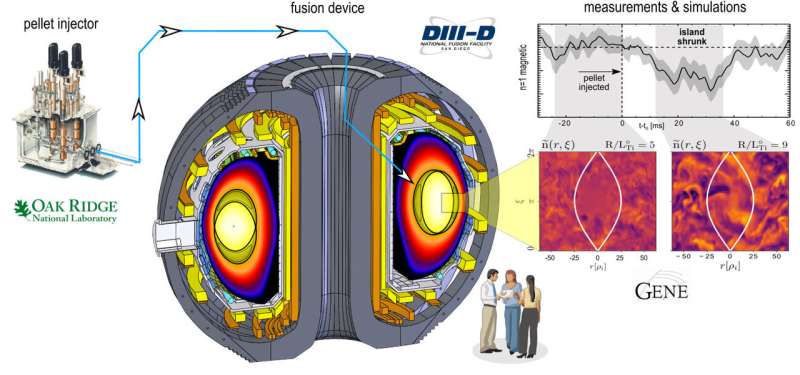Fuel injection helps reduce magnetic island instabilities

Fusion is a non-carbon-based process for energy production, where lighter atoms fuse into heavier ones. Fusion reactors operate by confining a "soup" of charged particles, known as a plasma, within powerful magnetic fields. But these magnetic fields must contain the plasma long enough that it can be heated to extreme temperatures—hotter than the sun—where fusion reactions can occur.
But like a balloon holding air, the magnetic fields can be leaky, allowing the plasma energy to escape. One form of a "leak" is a phenomenon known as a magnetic island. These are unstable structures within the magnetic fields that tear holes in the field and release energy from the plasma, stopping the fusion reaction. For future fusion power plants to produce electricity efficiently, the growth of magnetic islands must be prevented or eliminated. In some cases, the islands can be eliminated by driving a localized current inside them.
Recently, however, researchers at the DIII-D National Fusion Facility in San Diego discovered a new way to eliminate islands. They observed that firing frozen pellets of the hydrogen isotope deuterium deep into the plasma causes the magnetic islands to shrink. Using computer simulations, they determined that the shrinkage was likely caused by increased turbulence in the plasma due to the injected pellets (Figure 1). Theoretical calculations show that the shrunken islands can be completely eliminated with 70 percent less current inside the island than what is normally needed without the help of pellet injection.
"This is an important discovery, as it can extend the magnetic island control solution to operational regimes where other methods are not applicable," said Dr. Laszlo Bardoczi, the General Atomics scientist who led the effort. "In addition, it can free up heating and current drive resources that would otherwise be needed to maintain magnetic stability. Saving these resources will allow us to improve the net electricity output of a reactor, or they could be used to further manipulate the plasma to achieve better performance. Thus, the approach may offer substantial benefits for future reactors."
More information: Abstract:
Controlled Healing of NTMs by Fueling Pellets in DIII-D and KSTAR and Impact on ECCD Requirements for Complete NTM Stabilization
9:30 AM - 12:30 PM, Wednesday, October 23, 2019
Room: Floridian Ballroom AB
meetings.aps.org/Meeting/DPP19/Session/NI2.1
For additional information see also: Laszlo Bardoczi et al. Controlled NTM Healing by Fueling Pellets and its Impact on Electron Cyclotron Current Drive Requirements for Complete NTM Stabilization, Nuclear Fusion (2019). DOI: 10.1088/1741-4326/ab472d
Provided by American Physical Society



















